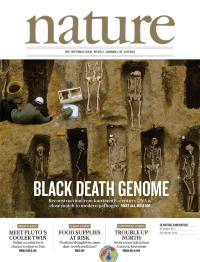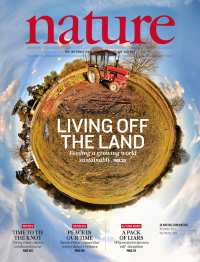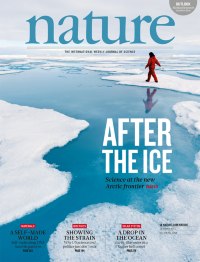Volume 478
-
No. 7370 27 October 2011
The latest DNA recovery and sequencing technologies have been used to reconstruct the genome of the Yersinia pestis bacterium responsible for the Black Death pandemic of bubonic plague that spread across Europe in the fourteenth century. The genome was pieced together from total DNA extracted from the skeletal remains of four individuals excavated from a large cemetery on the site of the Royal Mint in East Smithfield in London, where more than 2,000 plague victims were buried in 1348 and 1349. The draft genome sequence does not differ substantially from modern Y. pestis strains, providing no answer to the question of why the Black Death was more deadly than modern bubonic plague outbreaks. On the cover, the excavation at the site of the old Royal Mint, 1987 (Rex Features).
-
No. 7369 20 October 2011
In the coming years, continued population growth, rising incomes, increasing meat and dairy consumption and expanding biofuel use will place unprecedented demands on the world's agriculture and natural resources. With that backdrop, can we meet societys growing food needs while reducing agriculture's environmental harm? In an Analysis feature in this issue, an international team of environmental and agricultural scientists answers the question in the affirmative — but it will not be easy. Using new geospatial data and models, they evaluate how new approaches to agriculture could benefit both food production and environmental sustainability. They identify four strategies that could double food production while reducing environmental impacts. First, halt agricultural expansion. Second, close 'yield gaps' on underperforming lands. Third, increase cropping efficiency. And finally, we need to change our diets and shift crop production away from livestock feed, bioenergy crops and other non-food applications. (Cover: Image Source/Getty)
-
No. 7368 13 October 2011
The Arctic ice is melting, and with it goes many of the old assumptions about how science should be conducted in the Arctic Circle. In a series of News Feature and Comment pieces in this issue, we chart the changing picture of Arctic science, as well as the political and environmental consequences of the retreating ice.
Nature Outlook
-
No. 7367 6 October 2011
Underweight and obese phenotypes can both pose health risks. But whereas obesity has been associated with a number of genetic variants, little is known about the genetic basis of underweight. A large-scale screen of data from 28 cytogenetic centres in Europe and North America now shows that being underweight is frequently associated with duplication of a short region on chromosome 16. Deletion of this same chromosomal region has previously been associated with obesity. The observed associated phenotypes are opposites, or mirrors, of those reported in carriers of deletions at this locus, and correlate with changes in transcript levels for genes within the duplication but not within the adjacent regions. The suggestion is that severe obesity and being underweight could have mirror etiologies, possibly through contrasting effects on energy balance.




